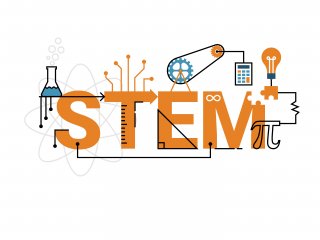
- Description
- Objectives
- Outline
- Materials
- System Requirements
Are you looking for new ways to foster communication, collaboration, critical thinking, and creativity skills for your students? Are you interested in STEM concepts but aren’t sure how to incorporate them into your elementary classroom? STEM stands for science, technology, engineering, and math which are all vital content areas for knowledge and development. Our STEM in the Elementary Classroom course will introduce you to STEM-infusion concepts and discuss why these concepts are important for children’s overall growth and development. Sample lesson plans, lesson plan templates, and STEM challenge ideas help to jumpstart brainstorming activities for integrating STEM into your classroom. We’ll also discuss ideas that support ways to engage other teachers, parents, and administrators.
After completing this course, you should be able to:
- Recognize the need for STEM-infusion and why STEM is critical to children’s growth
- Recall learning approaches for integrating STEM concepts
- Identify how to integrate content areas that provide both rigor and relevance to instruction
- Describe how student collaboration and proper leadership help to foster learning
STEM in the Elementary Classroom Module 1
STEM Infusing Content Areas
STEM-infusion means using concepts that are part of STEM to teach or practice all subjects in the classroom. This module will introduce you to basic STEM principles and why STEM concepts are important for elementary learners. We’ll also discuss how to make content and lessons relevant for students in order to enhance overall learning.
- Misconceptions about STEM-Infusion
- Why STEM in Elementary?
- 21st Century Readiness
- Rigor Meets Relevance
- The Role of Technology
STEM in the Elementary Classroom Module 2
Cross-Cutting Concepts and the Standards Alignment
This module addresses cross-cutting concepts and the standards alignment approach in relation to STEM-infusion. Cross-cutting concepts help students connect the dots between different content areas and this helps enrich their overall knowledge and understanding. Standards alignment is when the teacher looks at all the standards being taught and creates a design challenge that incorporates all of them.
- The Pattern Revelation
- Creating STEM-Infused Lesson Plans
- Starting with the Standards
- Connecting the Unconnected
- Brainstorming Project Ideas
STEM in the Elementary Classroom Module 3
Thematic Approaches and Assessing STEM
Thematic approaches use a theme, such as a story or event, as a foundation for a STEM-infused lesson. Module 3 will discuss ways to incorporate thematic approaches into your daily lesson planning. We will also address the proper ways to assess STEM, including rubrics, goal setting, student journaling, improvement logs, and standardized testing.
- Not Your Mama’s Thematic Teaching
- The Testing Mess
- Rubrics
- Student Goal Setting
- Student Journaling
STEM in the Elementary Classroom Module 4
STEM Mindset and Collaboration
The final module describes the benefits of STEM learning in terms of risk taking and shifting mindsets. We also discuss ideas for student collaboration and leadership concepts, such as modeling lessons in all classrooms, parent involvement, goal setting, and sharing resources amongst teachers, administrators, and parents.
- A Mindset Shift
- Foundation of Communication
- Richness of Interactions
- Leadership for Change
- Parent Involvement
Ed4Career is committed to being both environmentally conscious and making it easier for you to study! We’re making your education mobile! All of our textbooks are now provided as eTextbooks. You can access them on your laptop, tablet, or mobile device and can study anytime, anywhere.
The move away from physical books to eTextbooks means you get the latest, most up-to-date version available. This also makes your training more accessible, so you can study anywhere you have your phone or tablet. The best part is that all materials are included in your training cost so there are NO extra fees for books!
Internet Connection
- Broadband or High-Speed - DSL, Cable, and Wireless Connections
*Dial-Up internet connections will result in a diminished online experience. Classroom pages may load slowly and viewing large audio and video files may not be possible.
Hardware Requirements
- Processor - 2GHz Processor or Higher
- Memory - 1 GB RAM Minimum Recommended
PC Software Requirements
- Operating Systems - Windows 7 or higher
- Microsoft Office 2013 or higher. Also, you could use a general Word Processing application to save and open Microsoft Office formats (.doc, .docx, .xls, .xlsx, .ppt, .pptx)
- Internet Browsers - Google Chrome is highly recommended
- Cookies MUST be enabled
- Pop-ups MUST be allowed (Pop-up Blocker disabled)
- The Kindle Reader App or VitalSource Bookshelf App are needed for many of our courses (No special equipment needed. This can be downloaded for FREE onto your computer.)
- PowerPoint Viewer (if you do not have PowerPoint)
- Adobe PDF Reader
- QuickTime, Windows Media Player &/or Real Player
MAC Software Requirements
- Operating Systems - Mac OS x 10 or higher with Windows
- Mac office programs or a Word Processing application to save and open Microsoft Office formats (.doc, .docx, .xls, .xlsx, .ppt, .pptx)
- Internet Browsers- Google Chrome is highly recommended
- Cookies MUST be enabled
- Pop-ups MUST be allowed (Pop-up Blocker disabled)
- The Kindle Reader App or VitalSource Bookshelf App are needed for many of our courses (No special equipment needed. This can be downloaded for FREE onto your computer.)
- PowerPoint Viewer (if you do not have PowerPoint)
- Adobe PDF Reader
- Apple QuickTime Media Player
